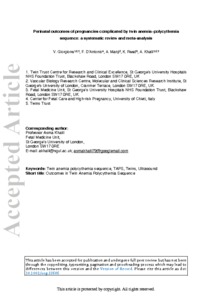Giorgione, V; D'Antonio, F; Manji, A; Reed, K; Khalil, A
(2021)
Perinatal outcome of pregnancy complicated by twin anemia–polycythemia sequence: systematic review and meta-analysis.
Ultrasound Obstet Gynecol, 58 (6).
pp. 813-823.
ISSN 1469-0705
https://doi.org/10.1002/uog.23585
SGUL Authors: Khalil, Asma
![[img]](https://openaccess.sgul.ac.uk/112842/1.hassmallThumbnailVersion/uog.23585.pdf)  Preview |
|
PDF
Accepted Version
Available under License ["licenses_description_publisher" not defined].
Download (1MB)
| Preview
|
Abstract
Objective
To report the perinatal outcome of monochorionic diamniotic (MCDA) twin pregnancies complicated by twin anemia–polycythemia sequence (TAPS), according to the type of TAPS (spontaneous or postlaser) and the management option adopted.
Methods
MEDLINE, EMBASE and The Cochrane Library databases were searched for studies reporting on the outcome of twin pregnancies complicated by TAPS. Inclusion criteria were non-anomalous MCDA twin pregnancies with a diagnosis of TAPS. The primary outcome was perinatal mortality; secondary outcomes were neonatal morbidity and preterm birth (PTB). The outcomes were stratified according to the type of TAPS (spontaneous or following laser treatment for twin–twin transfusion syndrome) and the management option adopted (expectant, laser surgery, intrauterine transfusion (IUT) or selective reduction (SR)). Random-effects meta-analysis of proportions was used to analyze the data.
Results
Perinatal outcome was assessed according to whether TAPS occurred spontaneously or after laser treatment in 506 pregnancies (38 studies). Intrauterine death (IUD) occurred in 5.2% (95% CI, 3.6–7.1%) of twins with spontaneous TAPS and in 10.2% (95% CI, 7.4–13.3%) of those with postlaser TAPS, while the corresponding rates of neonatal death were 4.0% (95% CI, 2.6–5.7%) and 9.2% (95% CI, 6.6–12.3%), respectively. Severe neonatal morbidity occurred in 29.3% (95% CI, 25.6–33.1%) of twins after spontaneous TAPS and in 33.3% (95% CI, 17.4–51.8%) after postlaser TAPS, while the corresponding rates of severe neurological morbidity were 4.0% (95% CI, 3.5–5.7%) and 11.1% (95% CI, 6.2–17.2%), respectively. PTB complicated 86.3% (95% CI, 77.2–93.3%) of pregnancies with spontaneous TAPS and all cases with postlaser TAPS (100% (95% CI, 84.3–100%)). Iatrogenic PTB was more frequent than spontaneous PTB in both groups. Perinatal outcome was assessed according to the management option adopted in 417 pregnancies (21 studies). IUD occurred in 9.8% (95% CI, 4.3–17.1%) of twins managed expectantly and in 13.1% (95% CI, 9.2–17.6%), 12.1% (95% CI, 7.7–17.3%) and 7.6% (95% CI, 1.3–18.5%) of those treated with laser surgery, IUT and SR, respectively. Severe neonatal morbidity affected 27.3% (95% CI, 13.6–43.6%) of twins in the expectant-management group, 28.7% (95% CI, 22.7–35.1%) of those in the laser-surgery group, 38.2% (95% CI, 18.3–60.5%) of those in the IUT group and 23.3% (95% CI, 10.5–39.2%) of those in the SR group. PTB complicated 80.4% (95% CI, 59.8–94.8%), 73.4% (95% CI, 48.1–92.3%), 100% (95% CI, 76.5–100%) and 100% (95% CI, 39.8–100%) of pregnancies after expectant management, laser surgery, IUT and SR, respectively.
Conclusions
The present meta-analysis provides pooled estimates of the risks of perinatal mortality, neonatal morbidity and PTB in twin pregnancies complicated by TAPS, stratified by the type of TAPS and the management option adopted. Although a direct comparison could not be performed, the results from this systematic review suggest that spontaneous TAPS may have a better prognosis than postlaser TAPS. No differences in terms of mortality and morbidity were observed when comparing different management options for TAPS, although these findings should be interpreted with caution in view of the limitations of the included studies. Individualized prenatal management, taking into account the severity of TAPS and gestational age, is currently the recommended strategy.
| Item Type: |
Article
|
| Additional Information: |
This is the peer reviewed version of the following article: Giorgione, V., D'antonio, F., Manji, A., Reed, K. and Khalil, A. (2021), Perinatal outcome of pregnancy complicated by twin anemia–polycythemia sequence: systematic review and meta-analysis. Ultrasound Obstet Gynecol, 58: 813-823, which has been published in final form at https://doi.org/10.1002/uog.23585. This article may be used for non-commercial purposes in accordance with Wiley Terms and Conditions for Use of Self-Archived Versions. |
| Keywords: |
TAPS, Twin anemia polycythemia sequence, Twins, Ultrasound, 1114 Paediatrics and Reproductive Medicine, Obstetrics & Reproductive Medicine |
| SGUL Research Institute / Research Centre: |
Academic Structure > Molecular and Clinical Sciences Research Institute (MCS) |
| Journal or Publication Title: |
Ultrasound Obstet Gynecol |
| ISSN: |
1469-0705 |
| Language: |
eng |
| Publisher License: |
Publisher's own licence |
| Projects: |
| Project ID | Funder | Funder ID |
|---|
| 765274 | Horizon 2020 | UNSPECIFIED |
|
| PubMed ID: |
33428243 |
 |
Go to PubMed abstract |
| URI: |
https://openaccess.sgul.ac.uk/id/eprint/112842 |
| Publisher's version: |
https://doi.org/10.1002/uog.23585 |
Statistics
Item downloaded times since 22 Jan 2021.
Actions (login required)
 |
Edit Item |



